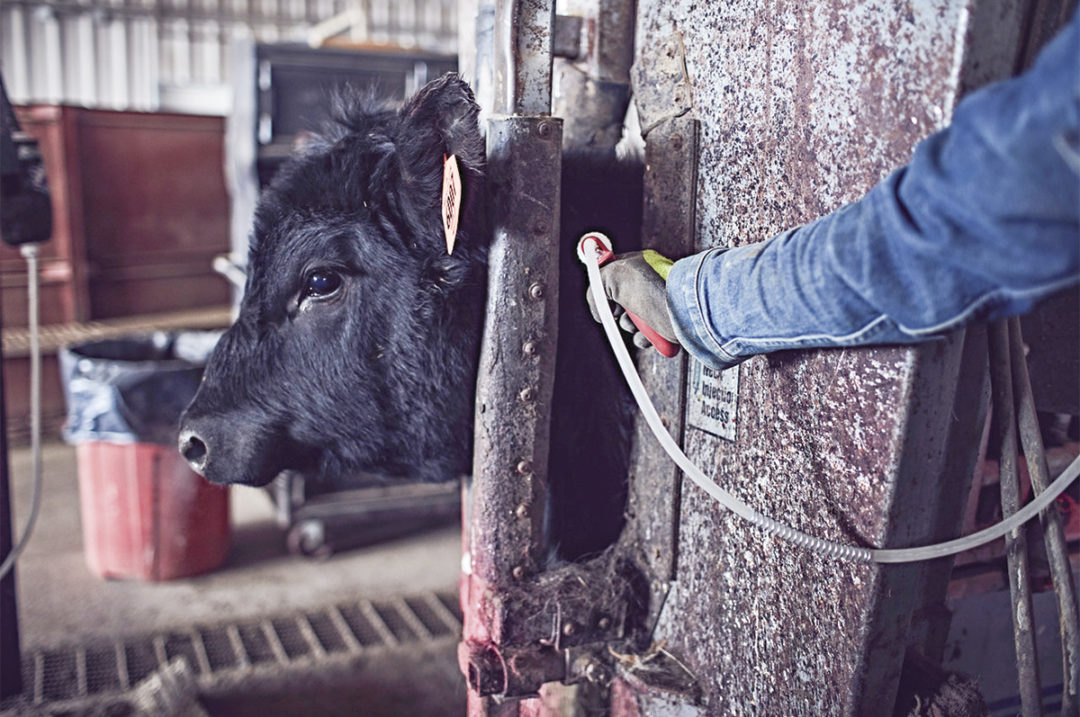From the moment a calf is born, the clock starts ticking in the battle against bovine respiratory disease (BRD). One of the things we try to promote as veterinarians is making sure that we stay ahead of it. BRD is the costliest disease in the cattle industry and can have serious impacts on an animal’s production potential.
Attacking BRD with a multifaceted approach that includes building immunity, mitigating risk and managing infections is important, and the timing of each action will impact its efficacy and the ability of the herd to fight back against disease.
Start strong with colostrum
Calves are born with a naive immune system, but colostrum provides them with essential passive immunity from their mothers. For a strong start, calves must receive 4 quarts of colostrum within the first four hours after birth.
To ensure the colostrum is high-quality and calves are passed as many antibodies as possible, it’s important for cows to be properly vaccinated and in good health.
Build immunity with early vaccination
As protection from antibody-rich colostrum wanes over time, calves need vaccines to stimulate their immune systems. Historically, it was thought that maternal antibodies found in colostrum would interfere with a vaccine’s efficacy when administered at too young of an age. However, it is now clear that the right vaccine can work in the presence of maternal antibodies and provide a robust immune response in young calves.
In a recent study, 30-day-old calves, with maternal antibodies present, were vaccinated with a unique adjuvanted 5-way plus Mannheimia haemolytica modified-live virus (MLV) injectable vaccine protocol or an intranasal and injectable vaccine protocol. Five months later, both groups were challenged with bovine viral diarrhea virus (BVDV) Type 1b, the most prevalent strain of BVDV in the U.S., and M. haemolytica.
Results showed the 5-way plus M. haemolytica MLV vaccine protocol provided a stronger immune response against BVDV Type 1b and M. haemolytica. It also decreased the level of BVDV shedding and kept rectal temperatures lower for several days compared to the intranasal and injectable vaccine protocol.
That’s not to say all injectable vaccines can do this. This particular vaccine product has a unique adjuvant that protects vaccine antigens from maternal antibodies, thus enhancing the immune response, even in calves still maintaining high levels of maternal antibodies acquired from colostrum.

Photo courtesy of Boehringer Ingelheim.
Emphasize stress mitigation to reduce disease risk
Quality colostrum and vaccination can get animals off to a great start, but even in a vaccinated animal, disease challenges can overwhelm the immune system.
Although some level of stress may be unavoidable, there are ways producers can remain diligent and proactive in protecting calves. By implementing a few of the following key management practices, producers can reduce risk, mitigate stress and prevent disease:
- Shield animals from harsh weather conditions.
- Practice low-stress handling to ensure the moving process goes smoothly for both producers and the cattle, such as presenting a calm disposition, avoiding loud noises, reducing the use of cattle prods and removing visual distractions.
- Ensure cattle are well fed with a properly balanced and highly nutritious diet. This is necessary for healthy immune function and proper growth.
- Work with a veterinarian to implement a deworming protocol for parasite protection.
- Consider metaphylaxis, or a group antibiotic treatment, for at-risk animals or any cattle with unknown health histories.
Introduce new animals slowly
Another important management decision comes when introducing any new animal to the herd. Minimizing commingling until new cattle are confirmed disease-free will help protect all animals. I recommend segregating new animals for at least 10 days, but waiting four weeks will further limit the risk of spreading infections. Screening new calves for BVDV and removing persistently infected calves are two great ways to protect current and future herds from BRD.
Producers should also consider purchasing animals in smaller groups and housing them in smaller, separate groups to increase bunk space and prevent the spread of disease. Overcrowding can encourage bullying during an already stressful time and prevent calves from getting adequate access to feed. Housing should be well-ventilated, have clean water and feeding areas, and shield cattle from harsh weather conditions.
Manage infections with timely, targeted treatment
Even with the best management practices and a thorough vaccination program, some infections are inevitable. According to Texas A&M University, producers can expect that nearly 20% of all beef cattle will require clinical treatment for BRD at some point in their lives. However, treating these infections in a timely and efficient manner can help get the best treatment outcome.
I recommend a long-lasting, fast-acting antibiotic that covers the four main bacteria that we worry about the most when it comes to BRD: M. haemolytica, Pasteurella multocida, Histophilus somni and Mycoplasma bovis.
Early diagnosis is crucial to BRD treatment success, and all employees should be trained to recognize the clinical signs of BRD. It is also important to consider implementing diagnostic testing to pinpoint exactly what pathogen the operation is fighting against. This allows veterinarians and producers to choose the most effective antibiotic for the bug the herd is facing and encourages antibiotic stewardship.
I want to emphasize the importance of having a plan to keep animals healthy. Proactive BRD management and help from a veterinarian can ensure action against BRD is taken in a timely, effective manner. I encourage producers to use this outline as a resource to set their herd up for success.










